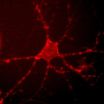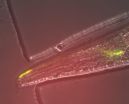(Press-News.org) For years, neuroscientists have been trying to develop tools that would allow them to clearly view the brain's circuitry in action—from the first moment a neuron fires to the resulting behavior in a whole organism. To get this complete picture, neuroscientists are working to develop a range of new tools to study the brain. Researchers at Caltech have developed one such tool that provides a new way of mapping neural networks in a living organism.
The work—a collaboration between Viviana Gradinaru (BS '05), assistant professor of biology and biological engineering, and Frances Arnold, the Dick and Barbara Dickinson Professor of Chemical Engineering, Bioengineering and Biochemistry—was described in two separate papers published this month.
When a neuron is at rest, channels and pumps in the cell membrane maintain a cell-specific balance of positively and negatively charged ions within and outside of the cell resulting in a steady membrane voltage called the cell's resting potential. However, if a stimulus is detected—for example, a scent or a sound—ions flood through newly open channels causing a change in membrane voltage. This voltage change is often manifested as an action potential—the neuronal impulse that sets circuit activity into motion.
The tool developed by Gradinaru and Arnold detects and serves as a marker of these voltage changes.
"Our overarching goal for this tool was to achieve sensing of neuronal activity with light rather than traditional electrophysiology, but this goal had a few prerequisites," Gradinaru says. "The sensor had to be fast, since action potentials happen in just milliseconds. Also, the sensor had to be very bright so that the signal could be detected with existing microscopy setups. And you need to be able to simultaneously study the multiple neurons that make up a neural network."
The researchers began by optimizing Archaerhodopsin (Arch), a light-sensitive protein from bacteria. In nature, opsins like Arch detect sunlight and initiate the microbes' movement toward the light so that they can begin photosynthesis. However, researchers can also exploit the light-responsive qualities of opsins for a neuroscience method called optogenetics—in which an organism's neurons are genetically modified to express these microbial opsins. Then, by simply shining a light on the modified neurons, the researchers can control the activity of the cells as well as their associated behaviors in the organism.
Gradinaru had previously engineered Arch for better tolerance and performance in mammalian cells as a traditional optogenetic tool used to control an organism's behavior with light. When the modified neurons are exposed to green light, Arch acts as an inhibitor, controlling neuronal activity—and thus the associated behaviors—by preventing the neurons from firing.
However, Gradinaru and Arnold were most interested in another property of Arch: when exposed to red light, the protein acts as a voltage sensor, responding to changes in membrane voltages by producing a flash of light in the presence of an action potential. Although this property could in principle allow Arch to detect the activity of networks of neurons, the light signal marking this neuronal activity was often too dim to see.
To fix this problem, Arnold and her colleagues made the Arch protein brighter using a method called directed evolution—a technique Arnold originally pioneered in the early 1990s. The researchers introduced mutations into the Arch gene, thus encoding millions of variants of the protein. They transferred the mutated genes into E. coli cells, which produced the mutant proteins encoded by the genes. They then screened thousands of the resulting E. coli colonies for the intensities of their fluorescence. The genes for the brightest versions were isolated and subjected to further rounds of mutagenesis and screening until the bacteria produced proteins that were 20 times brighter than the original Arch protein.
A paper describing the process and the bright new protein variants that were created was published in the September 9 issue of the Proceedings of the National Academy of Science.
"This experiment demonstrates how rapidly these remarkable bacterial proteins can evolve in response to new demands. But even more exciting is what they can do in neurons, as Viviana discovered," says Arnold.
In a separate study led by Gradinaru's graduate students Nicholas Flytzanis and Claire Bedbrook, who is also advised by Arnold, the researchers genetically incorporated the new, brighter Arch variants into rodent neurons in culture to see which of these versions was most sensitive to voltage changes—and therefore would be the best at detecting action potentials. One variant, Archer1, was not only bright and sensitive enough to mark action potentials in mammalian neurons in real time, it could also be used to identify which neurons were synaptically connected—and communicating with one another—in a circuit.
The work is described in a study published on September 15 in the journal Nature Communications.
"What was interesting is that we would see two cells over here light up, but not this one over there—because the first two are synaptically connected," Gradinaru says. "This tool gave us a way to observe a network where the perturbation of one cell affects another."
However, sensing activity in a living organism and correlating this activity with behavior remained the biggest challenge. To accomplish this goal Gradinaru's team worked with Paul Sternberg, the Thomas Hunt Morgan Professor of Biology, to test Archer1 as a sensor in a living organism—the tiny nematode worm C. elegans. "There are a few reasons why we used the worms here: they are powerful organisms for quick genetic engineering and their tissues are nearly transparent, making it easy to see the fluorescent protein in a living animal," she says.
After incorporating Archer1 into neurons that were a part of the worm's olfactory system—a primary source of sensory information for C. elegans—the researchers exposed the worm to an odorant. When the odorant was present, a baseline fluorescent signal was seen, and when the odorant was removed, the researchers could see the circuit of neurons light up, meaning that these particular neurons are repressed in the presence of the stimulus and active in the absence of the stimulus. The experiment was the first time that an Arch variant had been used to observe an active circuit in a living organism.
Gradinaru next hopes to use tools like Archer1 to better understand the complex neuronal networks of mammals, using microbial opsins as sensing and actuating tools in optogenetically modified rodents.
"For the future work it's useful that this tool is bifunctional. Although Archer1 acts as a voltage sensor under red light, with green light, it's an inhibitor," she says. "And so now a long-term goal for our optogenetics experiments is to combine the tools with behavior-controlling properties and the tools with voltage-sensing properties. This would allow us to obtain all-optical access to neuronal circuits. But I think there is still a lot of work ahead."
One goal for the future, Gradinaru says, is to make Archer1 even brighter. Although the protein's fluorescence can be seen through the nearly transparent tissues of the nematode worm, opaque organs such as the mammalian brain are still a challenge. More work, she says, will need to be done before Archer1 could be used to detect voltage changes in the neurons of living, behaving mammals.
And that will require further collaborations with protein engineers and biochemists like Arnold.
"As neuroscientists we often encounter experimental barriers, which open the potential for new methods. We then collaborate to generate tools through chemistry or instrumentation, then we validate them and suggest optimizations, and it just keeps going," she says. "There are a few things that we'd like to be better, and through these many iterations and hard work it can happen."
INFORMATION:
The work published in both papers was supported with grants from the National Institutes of Health (NIH), including an NIH/National Institute of Neurological Disorders and Stroke New Innovator Award to Gradinaru; Beckman Institute funding for the BIONIC center; grants from the U.S. Army Research Office as well as a Caltech Biology Division Training Grant and startup funds from Caltech's President and Provost, and the Division of Biology and Biological Engineering; and other financial support from the Shurl and Kay Curci Foundation and the Life Sciences Research Foundation.
Sensing neuronal activity with light
A technique developed by Caltech researchers uses a genetic tool and light to view and map neuronal circuits
2014-09-18
ELSE PRESS RELEASES FROM THIS DATE:
No sedative necessary: Scientists discover new 'sleep node' in the brain
2014-09-18
BUFFALO, N.Y. – A sleep-promoting circuit located deep in the primitive brainstem has revealed how we fall into deep sleep. Discovered by researchers at Harvard School of Medicine and the University at Buffalo School of Medicine and Biomedical Sciences, this is only the second "sleep node" identified in the mammalian brain whose activity appears to be both necessary and sufficient to produce deep sleep.
Published online in August in Nature Neuroscience, the study demonstrates that fully half of all of the brain's sleep-promoting activity originates from the parafacial ...
Miranda: An icy moon deformed by tidal heating
2014-09-18
Boulder, Colo., USA – Miranda, a small, icy moon of Uranus, is one of the most visually striking and enigmatic bodies in the solar system. Despite its relatively small size, Miranda appears to have experienced an episode of intense resurfacing that resulted in the formation of at least three remarkable and unique surface features -- polygonal-shaped regions called coronae.
These coronae are visible in Miranda's southern hemisphere, and each one is at least 200 km across. Arden corona, the largest, has ridges and troughs with up to 2 km of relief. Elsinore corona has ...
Research milestone in CCHF virus could help identify new treatments
2014-09-18
SAN ANTONIO, September 18, 2014 – New research into the Crimean-Congo hemorrhagic fever virus (CCHFV), a tick-borne virus which causes a severe hemorrhagic disease in humans similar to that caused by Ebolavirus, has identified new cellular factors essential for CCHFV infection. This discovery has the potential to lead to novel targets for therapeutic interventions against the pathogen.
The research, reported in a paper published today in the journal PLoS Pathogens and conducted by scientists at the Texas Biomedical Research Institute and their colleagues, represents ...
Microplastic pollution discovered in St. Lawrence River sediments
2014-09-18
A team of researchers from McGill University and the Quebec government have discovered microplastics (in the form of polyethylene 'microbeads', END ...
A new quality control pathway in the cell
2014-09-18
Proteins are important building blocks in our cells and each cell contains millions of different protein molecules. They are involved in everything from structural to regulatory aspects in the cell. Proteins are constructed as linear molecules but they only become functional once they are folded into specific three-dimensional structures. Several factors, like mutations, stress and age, can interfere with this folding process and induce protein misfolding. Accumulated misfolded proteins are toxic and to prevent this, cells have developed quality control systems just like ...
Small, fast, and crowded: Mammal traits amplify tick-borne illness
2014-09-18
(Millbrook, N.Y.) In the U.S., some 300,000 people are diagnosed with Lyme disease annually. Thousands also suffer from babesiosis and anaplasmosis, tick-borne ailments that can occur alone or as co-infections with Lyme disease. According to a new paper published in PLOS ONE, when small, fast-living mammals abound, so too does our risk of getting sick.
In eastern and central North America, blacklegged ticks are the primary vectors for Lyme disease, babesiosis, and anaplasmosis. The pathogens that cause these illnesses are widespread in nature; ticks acquire them when ...
Curcumin, special peptides boost cancer-blocking PIAS3 to neutralize STAT3 in mesothelioma
2014-09-18
A common Asian spice and cancer-hampering molecules show promise in slowing the progression of mesothelioma, a cancer of the lung's lining often linked to asbestos. Scientists from Case Western Reserve University and the Georg-Speyer-Haus in Frankfurt, Germany, demonstrate that application of curcumin, a derivative of the spice turmeric, and cancer-inhibiting peptides increase levels of a protein inhibitor known to combat the progression of this cancer. Their findings appeared in the Aug. 14 online edition Clinical Cancer Research; the print version of the article will ...
A new way to prevent the spread of devastating diseases
2014-09-18
For decades, researchers have tried to develop broadly effective vaccines to prevent the spread of illnesses such as HIV, malaria, and tuberculosis. While limited progress has been made along these lines, there are still no licensed vaccinations available that can protect most people from these devastating diseases.
So what are immunologists to do when vaccines just aren't working?
At Caltech, Nobel Laureate David Baltimore and his colleagues have approached the problem in a different way. Whereas vaccines introduce substances such as antigens into the body hoping ...
LSU Health research discovers means to free immune system to destroy cancer
2014-09-18
New Orleans, LA – Research led by Paulo Rodriguez, PhD, an assistant research professor of Microbiology, Immunology & Parasitology at LSU Health New Orleans' Stanley S. Scott Cancer Center, has identified the crucial role an inflammatory protein known as Chop plays in the body's ability to fight cancer. Results demonstrate, for the first time, that Chop regulates the activity and accumulation of cells that suppress the body's immune response against tumors. The LSU Health New Orleans research team showed that when they removed Chop, the T-cells of the immune system mounted ...
NASA sees western edge of Tropical Storm Fung-Wong affecting Philippines
2014-09-18
The NASA-NOAA Suomi NPP satellite saw the western edge of Tropical Storm Fung-Wong over the central Philippines on Sept. 18. Fung-Wong developed on Sept. 17 as Tropical Depression 16W, and strengthened into a tropical storm by 5 p.m. EDT on Sept. 17.
When NASA-NOAA's Suomi NPP satellite passed over Tropical Storm Fung-Wong on Sept. 18 at 05:24 UTC and the Visible Infrared Imaging Radiometer Suite (VIIRS) instrument aboard captured a visible picture of the storm. The VIIRS instrument revealed that a thick band of powerful thunderstorms spiraled around the southwestern ...
LAST 30 PRESS RELEASES:
Numbers in our sights affect how we perceive space
SIMJ announces global collaborative book project in commemoration of its 75th anniversary
Air pollution exposure and birth weight
Obstructive sleep apnea risk and mental health conditions among older adults
How talking slows eye movements behind the wheel
The Ceramic Society of Japan’s Oxoate Ceramics Research Association launches new international book project
Heart-brain connection: international study reveals the role of the vagus nerve in keeping the heart young
Researchers identify Rb1 as a predictive biomarker for a new therapeutic strategy in some breast cancers
Survey reveals ethical gaps slowing AI adoption in pediatric surgery
Stimulant ADHD medications work differently than thought
AI overestimates how smart people are, according to HSE economists
HSE researchers create genome-wide map of quadruplexes
Scientists boost cell "powerhouses" to burn more calories
Automatic label checking: The missing step in making reliable medical AI
Low daily alcohol intake linked to 50% heightened mouth cancer risk in India
American Meteorological Society announces Rick Spinrad as 2026 President-Elect
Biomass-based carbon capture spotlighted in newly released global climate webinar recording
Illuminating invisible nano pollutants: advanced bioimaging tracks the full journey of emerging nanoscale contaminants in living systems
How does age affect recovery from spinal cord injury?
Novel AI tool offers prognosis for patients with head and neck cancer
Fathers’ microplastic exposure tied to their children’s metabolic problems
Research validates laboratory model for studying high-grade serous ovarian cancer
SIR 2026 delivers transformative breakthroughs in minimally invasive medicine to improve patient care
Stem Cell Reports most downloaded papers of 2025 highlight the breadth and impact of stem cell research
Oxford-led study estimates NHS spends around 3% of its primary and secondary care budget on the health impacts of heat and cold in England
A researcher’s long quest leads to a smart composite breakthrough
Urban wild bees act as “microbial sensors” of city health.
New study finds where you live affects recovery after a hip fracture
Forecasting the impact of fully automated vehicle adoption on US road traffic injuries
Alcohol-related hospitalizations from 2016 to 2022
[Press-News.org] Sensing neuronal activity with lightA technique developed by Caltech researchers uses a genetic tool and light to view and map neuronal circuits






